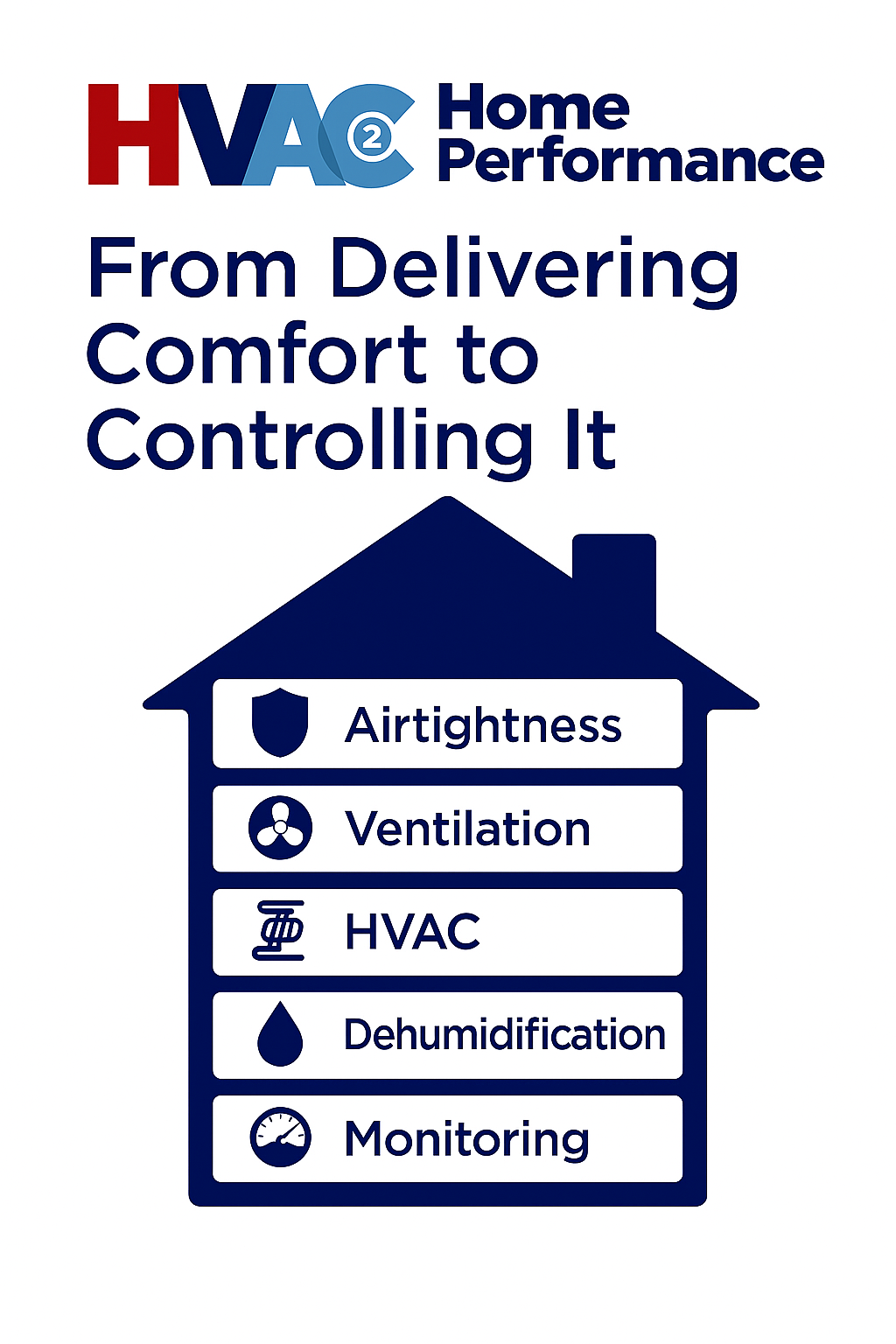
"Looking for design, commissioning support, or training that helps your projects move beyond delivering comfort and start controlling it? Reach out—we can help."
From Delivering Comfort to Controlling It
Have you ever wondered why the HVAC 2 Home Performance tagline is:
“From Delivering Comfort to Controlling It”?
It’s because in today’s homes, simply “delivering” comfort isn’t enough. Anyone can put in a piece of equipment and blow warm or cool air into a space. But true comfort—the kind that holds steady through heat waves, cold snaps, humidity swings, and daily life—only comes when it’s controlled.
And here’s the important distinction: HVAC 2 Home Performance doesn’t install equipment. We focus on the design, commissioning, and contractor training that make it possible for systems in the field to move from delivering to truly controlling comfort.
The Difference Between Delivery and Control
Delivering comfort is about the equipment. Controlling comfort is about the system. You can drop off the world’s best HVAC unit on a job site, but unless it’s commissioned properly, synced with ventilation, and matched to the building’s loads, you’re just guessing.
Comfort without control is like buying a sports car and never learning to use the brakes or gears. Sure, it runs—but it’s not safe, efficient, or predictable.
Permanent Load Reduction: Control Starts at the Source
When we talk about Permanent Load Reduction (PLR), most people think of smaller equipment. Less tonnage, lower bills. And that’s true—but it’s only half the story.
Permanent load reduction is really about control.
When infiltration is sealed, you control where outside air enters the home.
When insulation is upgraded, you control how heat moves through walls and ceilings.
When windows and shading are improved, you control solar gain before it ever spikes the thermostat.
In other words: PLR locks in the conditions that make true comfort possible. Without it, your HVAC system is forced to chase comfort reactively—bigger, louder, and less effective. With it, you’re building a house that’s predictable, stable, and easy to keep in the sweet spot.
That’s why PLR is more than just a way to shrink the load. It’s the foundation of moving from delivering comfort to controlling it.
The Layers of Control in a High-Performance Home
A home isn’t one system; it’s a stack of control layers that all need to work together.
Air Tightness & Enclosure: Comfort begins with a home that resists infiltration. Uncontrolled air is the enemy of control.
Ventilation & Dehumidification: Fresh air should be delivered on our terms—not by leaky construction. There are two proven ways to do it right:
Option A — One box (simple, tight control):
A Santa Fe ventilating dehumidifier brings in outdoor air and manages RH in the same unit. Fewer parts, one brain, and easy to commission or pair with IAQ triggers like HAVEN.Option B — Two boxes in series (when warranted):
An ERV followed by a whole-home dehumidifier. Outdoor air first passes through the ERV, where heat and moisture are exchanged. As air is returned from the home to the HVAC system and dehumidifier, if the house relative humidity creeps up above the set point the dehumidifier kicks on and does its thing.Key deciding factor: home tightness.
If blower door results (or predicted performance) are under 2.0 ACH50, we recommend an ERV to maintain balanced ventilation and ensure IAQ alongside comfort control.
At looser leakage rates, a ventilating dehumidifier alone often provides the simplest and most cost-effective path to control.
Other deciding factors include:
High latent climates or long humid shoulder seasons.
Ventilation requirements that exceed what a dehu-only system can comfortably manage.
Owner/program requirements (e.g., projects that mandate balanced ventilation regardless of ACH50).
HVAC Systems: Equipment needs to be more than installed. It has to be commissioned, balanced, and put under the correct controls so it responds to real-world conditions.
Monitoring & IAQ Intelligence: Tools like HAVEN take the guesswork out of IAQ and control by letting the house itself “tell” the system when to act.
Each of these is a control point. Put them together and you don’t just deliver comfort—you manage it, optimize it, and guarantee it.
Why This Matters
Comfort delivered but not controlled is fragile. It fails on the first humid summer, the first cold snap, or the first occupant complaint. Comfort controlled is resilient. It adapts. It’s measurable. And it lasts.
That’s the difference between a system that just meets code and one that truly performs.
The Takeaway
At HVAC 2 Home Performance, we don’t stop at delivering comfort. We put it under control. That means:
Designing systems that are right-sized and load-matched.
Commissioning systems so they perform as intended in the field.
Training contractors on how to move from “just delivering” to truly controlling comfort.
We’re not an installation company—we’re the partner behind the scenes making sure installation teams have the roadmap, tools, and training to succeed.
Because comfort isn’t something you give once. It’s something you control every day.
